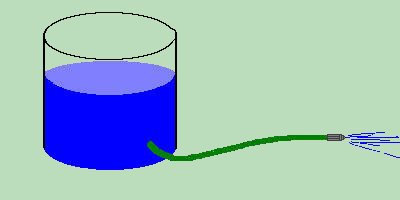


Voltage and CurrentAlready we have touched on the two terms VOLTAGE and CURRENT . Now it is time to discuss them further. VOLTAGE is the term used to describe the electrical "pressure" or difference of potential that we spoke of earlier. Just as water pressure is the force in physics that pushes water through a pipe, VOLTAGE is the physical force which pushes electrons through a wire. 
Examine illustration 4.1. You see a large tank with a hose attached to the bottom of the tank. When the tank is full of water, gravity causes that water to exert pressure, which pushes down toward the bottom of the tank. With the hose at the bottom, it allows a place for the water to escape. Water Pressure, therefore causes water current to flow through the hose. In the same sense, electrical pressure - just as water pressure pushes water through a pipe. Voltage , causes CURRENT to flow through a wire. VOLTAGE has several other names. It is sometimes called ELECTROMOTIVE FORCE (E.M.F. for short), IR DROP (this will be explained a little later), and POTENTIAL DIFFERENCE . The unit of measurement for VOLTAGE is the VOLT , and it is measured by a VOLTMETER . You may run into KiloVolt s (Thousand Volts), MilliVolt s (1 Thousandth of a Volt), or even MicroVolt s (1 Millionth of a Volt). The problem with discussing VOLTAGE is that it is difficult to talk about it, without discussing CURRENT and RESISTANCE in the same breath. The three are almost inseparable, as you will soon come to see. CURRENT (sometimes called Flow-Rate) is the term used to describe the MEASUREMENT of the FLOW or movement of electrons. The principle shouldn't be foreign to you by now. Water has current. Electricity has current. Water has current only when the river flows. If it is standing water, such as in a pond, it does not flow, and therefore has no current. Electricity only has current when it is on the move. Water that has flow, has a flow rate. That flow rate is called current. When water moves fast, we say the current is fast. When Electricity moves fast, we say it has high current. Current is measured in AMPERE s, using an AMMETER , typically discussed as MilliAmpere ( 1 thousandth of an Ampere ) s or MicroAmpere ( 1 millionth of an Ampere ) s. Quite often, for the sake of quick speech and quicker typing, it is shortened to just 'Amps or MilliAmps. |
| (On The Following Indicator... PURPLE will indicate your current location) | ||||||||||||||||||||||||
| 1 | 2 | 3 | 4 | 5 | 6 | 7 | 8 | 9 | 10 | 11 | 12 | 13 | 14 | 15 | 16 | 17 | 18 | 19 | 20 | 21 | 22 | 23 | 24 | 25 |
| 26 | 27 | 28 | 29 | 30 | 31 | 32 | 33 | 34 | 35 | 36 | 37 | 38 | 39 | 40 | 41 | 42 | 43 | 44 | 45 | 46 | 47 | 48 | 49 | 50 |
| 51 | 52 | 53 | 54 | 55 | 56 | 57 | 58 | 59 | 60 | 61 | 62 | 63 | 64 | 65 | 66 | 67 | 68 | 69 | 70 | 71 | 72 | 73 | 74 | 75 |
| Otherwise - please click to visit an advertiser so they know you saw their ad! |
